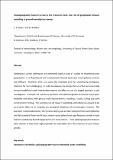Files in this item
Palaeogeographic reconstruction in the transition zone : the role of geophysical forward modelling in ground investigation surveys
Item metadata
| dc.contributor.author | Bates, Charles Richard | |
| dc.contributor.author | Bates, Martin | |
| dc.date.accessioned | 2017-08-31T23:31:57Z | |
| dc.date.available | 2017-08-31T23:31:57Z | |
| dc.date.issued | 2016-12 | |
| dc.identifier | 240790510 | |
| dc.identifier | fe83cbe9-fe88-42cb-b966-077cb03a6a45 | |
| dc.identifier | 84992220841 | |
| dc.identifier | 000392960900007 | |
| dc.identifier.citation | Bates , C R & Bates , M 2016 , ' Palaeogeographic reconstruction in the transition zone : the role of geophysical forward modelling in ground investigation surveys ' , Archaeological Prospection , vol. 23 , no. 4 , pp. 311-323 . https://doi.org/10.1002/arp.1546 | en |
| dc.identifier.issn | 1075-2196 | |
| dc.identifier.other | ORCID: /0000-0001-9147-7151/work/29591577 | |
| dc.identifier.uri | https://hdl.handle.net/10023/11579 | |
| dc.description.abstract | Geophysical survey techniques are commonly used as part of studies to reconstruct past geographies in archaeological and palaeoenvironmental landscape investigations onshore and offshore. However, their use across the intertidal zone for constructing contiguous models is far more challenging. In order to enhance the interpretation of the recovered data forward modelling is used here to demonstrate the effective use of a staged approach to site investigation. Examples of data from electrical and electromagnetic techniques have been modelled and tested with ground truth measurements including trial pits, coring and cone penetrometer testing. This combination of forward modelling and testing has proved to be particularly effective at mapping key geological situations of archaeological interest. The approach is demonstrated by reference to varying sub-surface sediment types exemplified by two field examples from the UK coast where typical palaeolandscape features, namely incised channels and deeply buried topographies are encountered. These palaeogeographic features were chosen as they have high potential for association with the evidence of past human activity. | |
| dc.format.extent | 1088021 | |
| dc.language.iso | eng | |
| dc.relation.ispartof | Archaeological Prospection | en |
| dc.subject | Geophysics | en |
| dc.subject | Boreholes | en |
| dc.subject | Palaeogeography | en |
| dc.subject | Buried channels | en |
| dc.subject | Peats | en |
| dc.subject | Modelling | en |
| dc.subject | G Geography (General) | en |
| dc.subject | T-NDAS | en |
| dc.subject.lcc | G1 | en |
| dc.title | Palaeogeographic reconstruction in the transition zone : the role of geophysical forward modelling in ground investigation surveys | en |
| dc.type | Journal article | en |
| dc.contributor.institution | University of St Andrews. Earth and Environmental Sciences | en |
| dc.contributor.institution | University of St Andrews. Centre for Ancient Environmental Studies | en |
| dc.contributor.institution | University of St Andrews. Marine Alliance for Science & Technology Scotland | en |
| dc.contributor.institution | University of St Andrews. Scottish Oceans Institute | en |
| dc.contributor.institution | University of St Andrews. St Andrews Sustainability Institute | en |
| dc.identifier.doi | 10.1002/arp.1546 | |
| dc.description.status | Peer reviewed | en |
| dc.date.embargoedUntil | 2017-08-31 |
This item appears in the following Collection(s)
Items in the St Andrews Research Repository are protected by copyright, with all rights reserved, unless otherwise indicated.

